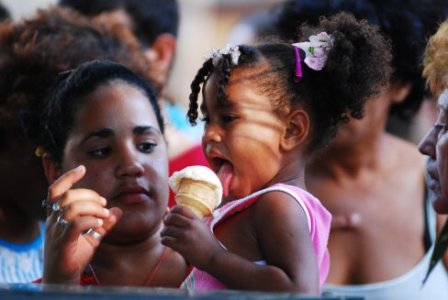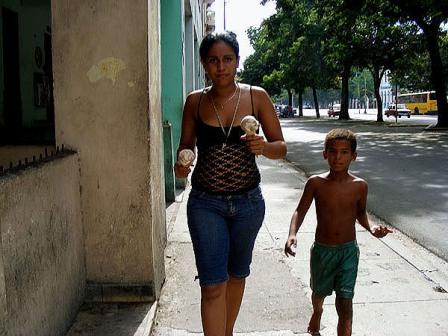Fewer Storks Visit Cuba’s Clinics
Patricia Grogg

HAVANA TIMES, Nov 17 (IPS) – Women in Cuba cite a variety of reasons to explain their decision to have only one child, ranging from the housing shortage to the rising cost of living and the many work responsibilities they have to shoulder. But many say that if things were different they would have a bigger family.
“In health matters we behave like the developed world, and now women only start to think about having children once they’re established in their careers,” Luis Ernesto Formoso, director of the “Ramón Gonzalez Coro” Obstetrics and Gynecology Hospital in Havana, said to IPS.
Dr. Formoso illustrates this assessment with his own personal history. “My grandmother had 16 children; my mother, four; and I have only one child,” he said, highlighting a trend in demographics that is at the root of the low fertility rates of a country with a public health system that provides free medical care for all women throughout pregnancy and childbirth.
“Cuban women like being mothers. But nowadays we plan our pregnancies better, and put off having children until the time is right,” the assistant director of the hospital’s nursing unit, Caridad Fuentes, said.
Fuentes, now 41, married young, at 19, and her two sons were born shortly after. “At first it was hard, but little by little I got the hang of it. I was able to study and work without neglecting my kids. My husband helped me out a lot; he’s one in a million,” she told IPS.
As a nurse, Fuentes has seen thousands of women give birth and she knows that when women become mothers when “conditions are not right” they have to pull three shifts to care for their family, study and work, with little time left over for their social lives. That’s the prospect faced by Heidi Guzman, a 23-year-old journalism student who’s expecting twins.
“It’s a huge challenge. I don’t think I’m prepared for it; but I have my whole family’s support – my mom, my grandparents, my in-laws. For my parents, since I’m an only child, my twins will be their first granddaughters,” said Guzman, who was admitted to the “Leonor Perez” maternity home in Old Havana 20 weeks into her pregnancy.
Keys to a healthy motherhood
Maternity homes were first set up in the 1960s in remote areas of Cuba to bring women in their late stages of pregnancy closer to hospitals. They were then expanded to every municipality in the country and are now key to ensuring adequate maternal and child health care.

The medical staff at these homes works to reduce risks common in pregnancy, such as anemia, gestational diabetes, high blood pressure, vaginal infections, or stunted fetal growth. They also take in pregnant teenagers or women who become pregnant around or over the age of 40.
“I’m much better off here than in my own home; everyone takes care of me,” 16-year-old Neysi Moya, 24 weeks pregnant, told IPS. She’s staying at the “Guira de Melena” maternity home, some 40 kilometers from the capital. In a room near Moya’s, Bárbara Valdes, 43, is expecting her third child. “I’m an Adventist, and they respect the restrictions in my diet, substituting thing I can’t eat because of my religion,” she said.
Some women stay in the maternity homes until their due date, when they’re transferred to the nearest hospital to deliver their babies. Others are discharged earlier in their pregnancy, only staying long enough to reduce or eliminate whatever risks they face. At these homes the mothers-to-be eat a healthy balanced diet, suitable to their needs, and are given a nutritional supplement if necessary.
“These facilities also serve lunch and dinner for a number of pregnant women who live in their own homes but eat there daily,” explained Milagros Rivero, a doctor who works in the maternal and child health care program.
With a system ranging from the family doctor and neighborhood health clinic to the national network of hospitals, where 99.9 percent of all mothers give birth today, Cuba has been able to reduce the maternal mortality rate from 120 per 100,000 live births in 1960 to 30.2 in 2007, according to official figures.
“We have a well-established program,” Formoso said, proudly pointing out that the country also has an extremely low infant mortality rate – 4.7 per 1,000 live births in 2008. He added that the number of teenage pregnancies has also been cut thanks to the “arsenal of information” that teenagers receive and the use of safe birth control methods.
“Unfortunately, not all unwanted pregnancies are prevented, but we’re seeing fewer and fewer abortions, even though they are legal – a major gain for Cuban women, who have this option available until their ninth, and in some cases tenth, week of pregnancy, provided it doesn’t put their health at risk,” Formoso noted.
Fewer babies on the horizon
The high level of education attained by women, the widespread use of birth control, and the high number of abortions – decriminalized in 1965 – are among the leading causes in the drop in Cuba’s birth rate over the last decades. Experts also point to economic difficulties and the rising divorce rate, which in 2008 stood at 3.2 per 1,000 inhabitants.

In a study on Cuba’s new social policy challenges, made available to IPS, social researchers Patricia Ares and Maria Elena Benitez note that since 1978 Cuban couples are having less than the 2.1 average births necessary to guarantee the replacement of the ageing population.
According to the study’s authors, Cuban women “really want to have children,” but at the same time they want to be able to choose “when and who to marry, when to become a mother and how many children they’ll have, and whether they will marry or just live together.” However, they put off motherhood for “when things get better.”
This trend is combined with the accelerated ageing of the population, almost a fifth of which (17 percent) is already 60 years or older. By 2025 one in every four Cubans is expected to be in this age group.
In Ares’ and Benítez’ opinion, the policy that the State needs to adopt to effectively address the challenges posed by its demographics in the near future must include efforts aimed at motivating women to have more children, and to do that it must focus on helping them overcome the major difficulties that have been identified.
For example, day care facilities need to be expanded, especially considering that 53 percent of mothers of children four or younger work, and the challenge lies in allowing women to have the number of children they want without compromising their involvement in social and labor activities.
The authors also suggest building new housing specially designed to accommodate young families with more than one child, and providing affordable access to basic goods that are essential for raising a baby.
With these and other measures, the State would be responding to the families’ need for outside help. “Population policies cannot be separated from a country’s economic and social policies, which must be aimed at guaranteeing the reconciliation of personal, family and professional life,” the study’s experts say.






Interesting article. A Cuban once said to me that Cuba is a country of “viejitos” and “viejitas” – elderly people. Of course my country, Canada, is a country of elderly people as well when you only include Canadians born in Canada – the difference is that Canada brings in children and immgrants who have children fom all over the world so Canada does not look like Cuba (demographically). For example, several of my neighbours have children from China and two new little girls just arrived at my daughters’ school – one from Cuba and one from Colombia. Very few countries in the world can attract immigrants like Canada – putting us at hugely unfair advantage to countries like Cuba. On top of that – immigrants to Canada are paid less than people born in Canada – allowing Canadians to consume more goods and servcices on the backs of immigrants.